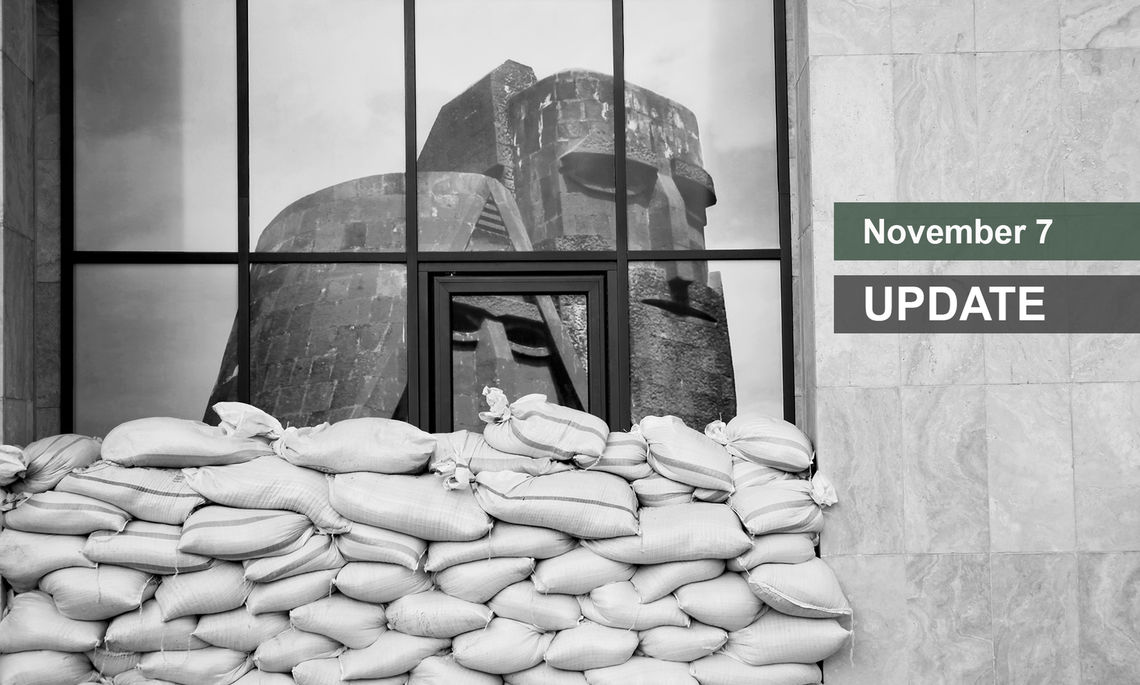
The Azerbaijani side is doing everything in its power to capture the symbolic fortress town of Shushi. This evening, during his regular press briefing, Artsrun Hovhannisyan of the Defense Ministry said that Azerbaijan has brought new forces into play and has been able to advance closer to Shushi. He said that it is the third day now that intense battles have been taking place around the city, including in Karin Tak and Lisagor. “As these battles are unfolding and the city is fighting till the end, it is our duty to trust Armenian servicemen,” Hovhannisyan said.
Here is a chronology of official updates.
9:50 a.m.: Defense Ministry spokesperson Shushan Stepanyan, announced that, at approximately 6:45 a.m., the air defense units of the Defense Army shot down an Azerbaijani UAV in the eastern direction of the front line.
10:30 a.m.: The Artsakh Defense Ministry reported that military operations continued along the entire length of the front line overnight. The most intense battles took place in the Shushi-Karin Tak area. According to the Ministry, units of the Artsakh Defense Army suppressed the Azerbaijani offensives and inflicted significant human losses.
Artsakh Refugees Dream of Home as War Rages On
It had been almost two decades since Gohar Karapetyan last made the trip from Artsakh to Yerevan when she decided, on the morning of October 1, to repeat the journey, this time to escape a raging war.
Read moreNovember 6
Arman Tatoyan and Artak Beglaryan Joint Report
The Human Rights Defender of Armenia and the Human Rights Ombudsman of Artsakh (Nagorno-Karabakh) published an ad hoc report on the use of incendiary ammunition of mass destruction (incendiary weapon) containing chemical elements (possibly white phosphorus) against Artsakh by the Azerbaijani armed forces.
Findings of the report are based on presented evidence (photos of civilians’ body injuries, map illustrations, etc.). Specific findings are based on studies of the Military Medicine Faculty of Mkhitar Heratsi Yerevan State Medical University.
Joint studies by the two human rights institutions proved that the incendiary ammunition was used against civilian objects and forests of Artsakh, causing severe long-term damage to the peaceful population and environment.
In many cases where forests were targeted with incendiary ammunition, civilian communities (e.g. Nngi, Sghnakh, Aknaghbyur, Taghavard, Togh, Qarin Tak) are nearby, sometimes within only 100 meters. Hence, the issue is also related to the inevitable long-term impact on the health of the civilian population.
The joint fact-finding missions of the two Human Rights Defenders revealed that overall approximately 1815 hectares of forest area were damaged, spanning almost all the regions of Artsakh. Considering the specificities of the ammunition, this number may increase, even if its further use is discontinued.
Moreover, it was also reported that, in civilian communities (e.g. Nngi, Taghavard, Aknaghbyur), vital civilian objects (e.g. gas pipelines) were destroyed.
The ad hoc report established at least the following facts, irrespective of the specific type of chemical element used in the ammunition:
1) the ammunition used was meant for mass destruction;
2) the ammunition contained chemical elements;
3) the ammunition was used to target forests, causing wildfires and severe long-term damage to the environment;
4) according to expert assessments, the fire caused by this type of weapon is resistant to usual extinguishing agents including water;
5) the forests where this ammunition was used are located close to civilian communities;
6) according to fact-finding activities, civilians who had sought shelter from Azerbaijani attacks in the forests were likely injured from the use of the ammunition;
7) the use of this ammunition against civilian objects is prohibited by international law and may entail a war crime.


